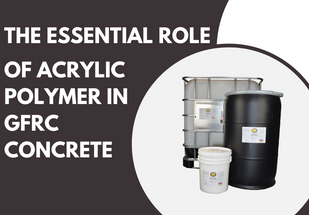Oct 30th 2023
The Essential Role of Acrylic Polymer in GFRC Concrete
In the world of concrete, there exists a versatile and high-performance material known as Glass Fiber Reinforced Concrete (GFRC). This innovative form of concrete combines the strength of traditional concrete with the flexibility and lightweight properties of glass fibers. What makes GFRC truly exceptional, however, is the critical role that acrylic polymer plays in its composition. In this article, we will delve into the importance of acrylic polymer in GFRC concrete and why it is so important in the construction industry.
Understanding GFRC Concrete
Before we dive into the significance of acrylic polymer in GFRC, let's first understand what GFRC concrete is and why it's gaining popularity in construction.
GFRC is a composite material made by mixing cement, sand, water, and alkali-resistant glass fibers. The result is a concrete that is not only significantly lighter than traditional concrete but also boasts impressive tensile and flexural strength. This unique combination of properties makes GFRC an ideal choice for a wide range of architectural applications, including façades, countertops, sinks, and more.
The Role of Acrylic Polymer
Acrylic polymer, often referred to as a "GFRC admixture," is the secret sauce that elevates GFRC concrete to a superior material for construction. Here's why it's so essential:
1. Enhanced Flexibility and Durability: Acrylic polymer serves as a bonding agent that effectively bridges the gap between the cement matrix and the glass fibers, creating a robust, flexible matrix that can withstand a wide range of stresses and strains. This results in greater durability, reducing the likelihood of cracking and increasing resilience in challenging environmental conditions.
2. Improved Workability: Acrylic polymer helps maintain the workability of the GFRC mix, allowing for greater creative freedom in shaping and designing architectural elements.
3. Reduced Weight: Acrylic polymer lowers the density of the concrete while maintaining its structural integrity, making GFRC lightweight and ideal for transportation and installation.
4. Enhanced Resistance: Acrylic polymer enhances the resistance of GFRC to alkali, moisture, and chemicals, ensuring that it remains structurally sound and aesthetically pleasing over time, even in harsh environments.
5. Improved Aesthetics: Acrylic polymer provides a smooth surface finish that can be customized with various textures, colors, and patterns, contributing to the material's visual appeal.
6. Elimination of 7-Day Wet Cure: Acrylic polymer helps eliminate the need for the traditional 7-day wet curing process, saving time and resources in construction projects.
7. Enhanced Concrete Hydration: Acrylic polymer aids in the hydration of concrete, promoting the chemical reactions between water and cement that contribute to the concrete's strength and durability.
Applications of GFRC with Acrylic Polymer
The combination of GFRC and acrylic polymer opens up a world of possibilities in construction and design. Here are some notable applications:
1. Architectural Façades: GFRC panels with acrylic polymer are a popular choice for cladding building exteriors, as they offer both long term durability and aesthetic versatility.
2. Countertops and Sinks: The lightweight nature of GFRC makes it a preferred choice for creating custom countertops and sinks that are both stylish and long-lasting.
3. Decorative Elements: GFRC, when reinforced with acrylic polymer, is used to create intricate decorative elements such as moldings, sculptures, and ornamental details on buildings.
Conclusion
Acrylic polymer is the unsung hero of GFRC concrete. Its addition to the mix transforms GFRC into a construction material with unparalleled durability, workability, and aesthetic potential. As architects and builders continue to push the boundaries of design, the importance of acrylic polymer in GFRC becomes increasingly evident. This innovative combination is not just changing the face of construction but also allowing for a new era of architectural creativity and durability in the industry.

